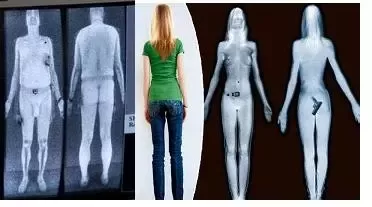Infrared radiation has been used in many aspects of our day-to-day lives. From medical imaging to night vision, infrared technology is ubiquitous. But can infrared radiation go through clothes? In this article, we’ll explore this question and examine the implications of infrared radiation passing through clothing. We’ll explore how infrared radiation can be used for surveillance, and what you can do to protect yourself from unwanted infrared radiation exposure. So let’s dive in and find out, can infrared go through clothes?
The answer to the question “Can infrared go through clothes?” is both yes and no. In general, infrared radiation does not penetrate through clothing, however, some materials can be more transparent than others. For example, thin fabrics such as silk and chiffon may allow some infrared radiation to pass through. Fibers such as wool and most synthetic fabrics are generally more effective at blocking infrared radiation.

Contents
Can Infrared Radiation Pass Through Clothing?
Infrared radiation, or IR, is a type of energy that exists in the electromagnetic spectrum. It is invisible to the human eye but can be detected by special equipment. The ability of infrared radiation to pass through clothing depends on the type of clothing and the material it is made from. In this article, we will explore the question of whether infrared radiation can penetrate materials such as fabric, leather, and rubber.
Infrared radiation is made up of three different types of waves: near, mid, and far. Near infrared radiation has the shortest wavelength and the highest frequency, while far infrared radiation has the longest wavelength and the lowest frequency. Each type of infrared radiation has different properties and can be used for different purposes. For example, near infrared radiation is used for night vision and infrared cameras, while far infrared radiation is used for medical imaging.
When it comes to clothing, the answer to the question of whether infrared radiation can pass through it depends on the type of fabric and the type of infrared radiation. In general, fabrics that are made of natural fibers such as cotton, wool, and silk are more likely to block infrared radiation than fabrics that are made of synthetic materials such as polyester, nylon, and rayon. Leather and rubber, on the other hand, tend to be more effective at blocking infrared radiation.
Near Infrared Radiation and Clothing
Near infrared radiation is the type of infrared radiation that has the shortest wavelength and the highest frequency. This type of radiation is used in night vision and infrared cameras, and it is the most likely to be blocked by clothing. Natural fibers such as cotton, wool, and silk are usually effective at blocking near infrared radiation, while synthetic materials such as polyester, nylon, and rayon are less effective. Leather and rubber are even more effective at blocking near infrared radiation.
When it comes to clothing, the thickness of the fabric can also affect how much near infrared radiation is blocked. Thicker fabrics are more likely to block near infrared radiation than thinner fabrics. For example, a thick wool coat is more likely to block near infrared radiation than a thin cotton shirt.
Mid Infrared Radiation and Clothing
Mid infrared radiation is the type of infrared radiation that has a medium wavelength and a medium frequency. This type of radiation is often used for medical imaging and is less likely to be blocked by clothing than near infrared radiation. Natural fibers such as cotton, wool, and silk are still effective at blocking mid infrared radiation, while synthetic materials such as polyester, nylon, and rayon are less effective. Leather and rubber are even more effective at blocking mid infrared radiation.
When it comes to clothing, the thickness of the fabric can still affect how much mid infrared radiation is blocked. However, thinner fabrics are more likely to block mid infrared radiation than thicker fabrics. For example, a thin cotton shirt is more likely to block mid infrared radiation than a thick wool coat.
Far Infrared Radiation and Clothing
Far infrared radiation is the type of infrared radiation that has the longest wavelength and the lowest frequency. This type of radiation is used for medical imaging and is the least likely to be blocked by clothing. Natural fibers such as cotton, wool, and silk are still effective at blocking far infrared radiation, while synthetic materials such as polyester, nylon, and rayon are less effective. Leather and rubber are even more effective at blocking far infrared radiation.
When it comes to clothing, the thickness of the fabric can still affect how much far infrared radiation is blocked. However, thinner fabrics are more likely to block far infrared radiation than thicker fabrics. For example, a thin cotton shirt is more likely to block far infrared radiation than a thick wool coat.
Conclusion
In conclusion, the ability of infrared radiation to pass through clothing depends on the type of clothing and the material it is made from. Near infrared radiation is the most likely to be blocked by clothing, while far infrared radiation is the least likely to be blocked. Natural fibers such as cotton, wool, and silk are more effective at blocking infrared radiation than synthetic materials such as polyester, nylon, and rayon. Leather and rubber are even more effective at blocking infrared radiation. The thickness of the fabric can also affect how much infrared radiation is blocked. Thicker fabrics are more likely to block near infrared radiation, while thinner fabrics are more likely to block mid and far infrared radiation.
Frequently Asked Questions
What is Infrared?
Infrared (IR) is a type of electromagnetic radiation. It’s a part of the electromagnetic spectrum, alongside other types of light such as visible, ultraviolet, and X-ray. Infrared radiation has a longer wavelength than visible light and is invisible to the human eye. This type of radiation is produced by objects that have a temperature above absolute zero.
Does Infrared Go Through Clothes?
Yes, infrared radiation can pass through clothing. Depending on the material, infrared radiation can pass through clothing relatively easily. Some fabrics, such as silk and wool, are more opaque and can block more of the infrared radiation. But even with these fabrics, some of the infrared radiation will still be able to pass through.
What is Infrared Used For?
Infrared radiation is used in a variety of applications. It is used in medical imaging, as infrared cameras are able to detect differences in temperature which can be used to diagnose illnesses. Infrared is also used in night vision, as it can be used to detect heat in the dark. Finally, infrared radiation is used in communications, as it is able to pass through clouds and dust.
What is Infrared Imaging?
Infrared imaging is the process of capturing and analyzing images based on the infrared radiation emitted from objects. Infrared imaging can be used to detect changes in temperature, which makes it useful for medical imaging and night vision. It can also be used to detect objects in the dark, as infrared radiation is able to pass through clouds and dust.
What is Infrared Heating?
Infrared heating is the process of using infrared radiation to heat objects. Infrared heaters generate infrared radiation which is then absorbed by the objects in the vicinity. Infrared heating is used in a variety of applications, such as space heating, solar thermal power, and industrial processes.
What is Infrared Technology?
Infrared technology is the use of infrared radiation in various applications. Infrared technology is used in medical imaging, night vision, communications, infrared imaging, and infrared heating. It is also used in industrial processes and in consumer electronics, such as remote controls. The use of infrared technology has allowed us to make use of the unique properties of infrared radiation and apply them to a variety of applications.
The Secret Reason Infrared Heat Can Heal Neck, Back, Shoulder, Hip Pain & More!
Conclusively, infrared can pass through clothes in some cases. However, the degree of penetration of infrared by clothes varies depending on the material of the clothing and the wavelength of the infrared radiation. In most cases, thin materials or fabrics like cotton or silk will allow some infrared radiation to pass through, while thicker materials such as wool or leather will block the infrared radiation from passing. Ultimately, it is best to consult a professional before attempting to use infrared radiation in a situation where clothing could be a factor.








